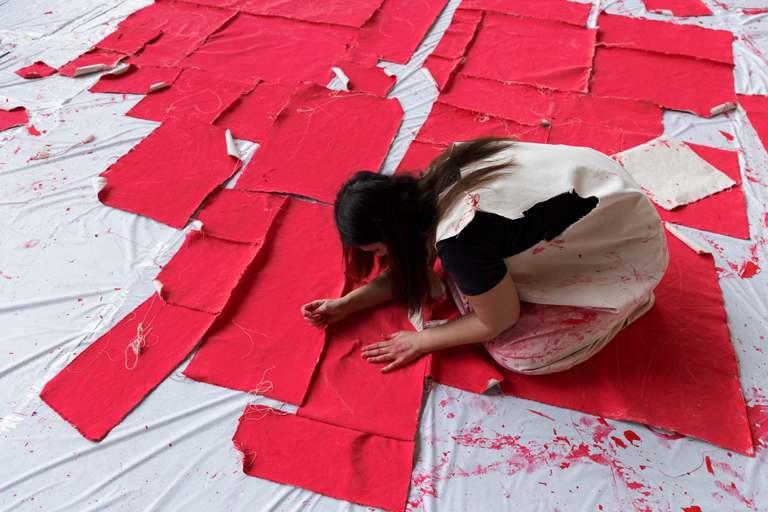Review by: Stefan Petranek, Associate Professor of Photography & Intermedia, Herron School of Art & Design, Indiana University Indianapolis
Review by: Stefan Petranek, Associate Professor of Photography & Intermedia, Herron School of Art & Design, Indiana University Indianapolis

Farnaz Farrokhi’s Our Blood is the Same Color is not merely an art exhibition, it is a radical, participatory experience that dissolves the boundary between artist and audience, demanding visceral engagement. Through an innovative and deeply symbolic use of materiality and performance, Farrokhi challenges deeply embedded notions of division and unity, inviting audiences into a transformative dialogue about human connection, prejudice, and collective action which leaves an indelible mark on both the body and mind. The work has been exhibited in prestigious international venues, including UN PLAZA in New York, Washington D.C., Indianapolis, Los Angeles and forthcoming exhibitions in Abu Dhabi, Doha, Dubai, and Berlin, marking it as a globally recognized cultural and social intervention. The work transcends traditional gallery boundaries to confront the fundamental elements of our shared humanity.
From the moment participants step into space, it becomes clear that Farrokhi's work eschews conventional aesthetics in favor of raw, unfiltered engagement. Stripped of elaborate frills, the installation invites individuals to partake in an act that is as tactile as it is symbolic: The process of smearing red pigment onto scraps of canvas with bare hands, rather than using brushes or traditional tools, is a potent metaphor for immediacy, vulnerability, and collective human experience. The physicality of this act—feeling the texture of the pigment, absorbing the color into the skin—creates an embodied interaction that underscores the universal yet personal significance of the color red. This act of direct, unmediated contact with the color red—an intensive hue loaded with connotations of love, connectedness, violence, and death—serves as a potent sensory metaphor.
The journey continues as the participants shift from the act of painting to sewing these pieces of crimson fabric together into a sprawling, interconnected grid where each piece of canvas represents an individual while the whole reflects the fabric of humanity. As such, this rough tapestry, assembled with care and collective effort, evolves into a visual allegory of both the societal and political divides that fracture communities as well as our shared interconnectedness as humans. Here, Farrokhi masterfully uses the medium of fabrics, something both fragile and enduring, to highlight how the smallest biases can escalate into profound societal suffering and even violent consequences when not treated with compassion.
A particularly powerful moment in the experience comes once participants complete their sewing and stand before a camera to affirm aloud, “our blood is the same color.” This declaration is not only a personal affirmation of unity but also a public confrontation of the artificial divisions that society imposes on itself. In doing so, Farrokhi’s work dismantles the constructed boundaries between “us” and “the other,” urging a re-examination of the social, racial, and ethnic labels that separate us.
The use of red in this context is as deliberate as it is evocative. While red might evoke images of spilled blood and mortality, it equally embodies passion, solidarity, and the vitality of human connection. Farrokhi’s project, therefore, awakens the senses to the stark reality that our most minute prejudices can escalate into catastrophic consequences. Yet, it simultaneously serves as a reminder of the transformative power of love and unity—a call to cast off the divisive markers that undermine our collective strength.
Since its inception, Our Blood is the Same Color has engaged over 400 global participants in this artistic call to action, demonstrating the outstanding capacity of this global art project. The sheer number of individuals who have actively contributed to this work underscores its unparalleled reach, influence, and ability to unite diverse communities through participatory performance. Such engagement is a testament to the profound resonance and universal relevance of Farrokhi’s artistic vision.
In summary, Farnaz Farrokhi’s Our Blood is the Same Color is a visceral and thought-provoking exploration of what it means to be human. By engaging participants in acts of creation that are both physical and symbolic, the work challenges us to confront our own biases and to embrace our shared humanity. It is an exhibition that not only celebrates art’s power to unite but also calls us to action in the ongoing struggle against division and isolation. Our Blood is the Same Color is an undeniable testament to the power of art as a catalyst for global change.